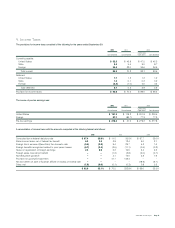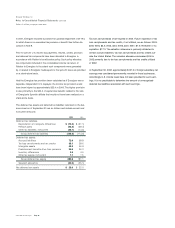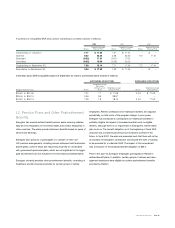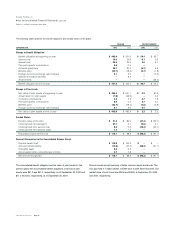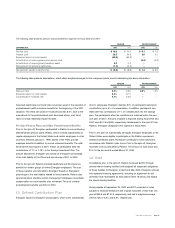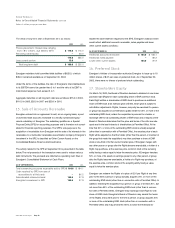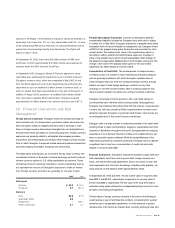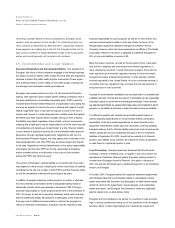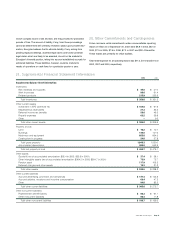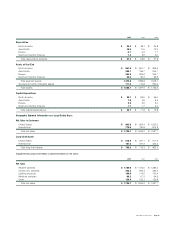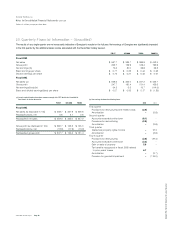Energizer 2002 Annual Report Download - page 42
Download and view the complete annual report
Please find page 42 of the 2002 Energizer annual report below. You can navigate through the pages in the report by either clicking on the pages listed below, or by using the keyword search tool below to find specific information within the annual report.
remaining maturities. Based on these considerations, Energizer would
receive a total net payment of zero and $6.7 for outstanding foreign cur-
rency contracts at September 30, 2002 and 2001, respectively. However,
these payments are unlikely due to the fact that Energizer enters into for-
eign currency contracts to hedge identifiable foreign currency exposures,
and as such would generally not terminate such contracts.
19. Environmental and Legal Matters
Government Regulation and Environmental Matters The operations of
Energizer, like those of other companies engaged in the battery business,
are subject to various federal, state, foreign and local laws and regulations
intended to protect the public health and the environment. These regula-
tions primarily relate to worker safety, air and water quality, underground
fuel storage tanks and waste handling and disposal.
Energizer has received notices from the U.S. Environmental Protection
Agency, state agencies and/or private parties seeking contribution, that it
has been identified as a “potentially responsible party” (PRP) under the
Comprehensive Environmental Response, Compensation and Liability Act,
and may be required to share in the cost of cleanup with respect to eight
federal “Superfund” sites. It may also be required to share in the cost of
cleanup with respect to a state-designated site. Liability under the applica-
ble federal and state statutes which mandate cleanup is strict, meaning
that liability may attach regardless of lack of fault, and joint and several,
meaning that a liable party may be responsible for all of the costs incurred
in investigating and cleaning up contamination at a site. However, liability
in such matters is typically shared by all of the financially viable responsi-
ble parties, through negotiated agreements. Negotiations with the U.S.
Environmental Protection Agency, the state agency that is involved on the
state-designated site, and other PRPs are at various stages with respect
to the sites. Negotiations involve determinations of the actual responsibility
of Energizer and the other PRPs at the site, appropriate investigatory
and/or remedial actions, and allocation of the costs of such activities
among the PRPs and other site users.
The amount of Energizer’s ultimate liability in connection with those sites
may depend on many factors, including the volume and toxicity of material
contributed to the site, the number of other PRPs and their financial viabili-
ty, and the remediation methods and technology to be used.
In addition, Energizer undertook certain programs to reduce or eliminate
the environmental contamination at the rechargeable battery facility in
Gainesville, Florida, which was divested in November 1999. The buyer
assumed responsibility for those programs at the time of the divestiture. In
2001, the buyer, as well as its operating subsidiary which owns and oper-
ates the Gainesville facility, filed petitions in bankruptcy. In the event that
the buyer and its affiliates become unable to continue the programs to
reduce or eliminate contamination, Energizer could be required to bear
financial responsibility for such programs as well as for other known and
unknown environmental conditions at the site. Under the terms of the
Reorganization Agreement between Energizer and Ralston Purina
Company, however, which has been assumed by an affiliate of The Nestlé
Corporation, Ralston’s successor is obligated to indemnify Energizer for
50% of any such liabilities in excess of $3.
Many European countries, as well as the European Union, have been
very active in adopting and enforcing environmental regulations. In
many developing countries in which Energizer operates, there has not
been significant governmental regulation relating to the environment,
occupational safety, employment practices or other business matters
routinely regulated in the United States. As such economies develop, it
is possible that new regulations may increase the risk and expense of
doing business in such countries.
Accruals for environmental remediation are recorded when it is probable that
a liability has been incurred and the amount of the liability can be reasonably
estimated, based on current law and existing technologies. These accruals
are adjusted periodically as assessments take place and remediation efforts
progress, or as additional technical or legal information becomes available.
It is difficult to quantify with certainty the potential financial impact of
actions regarding expenditures for environmental matters, particularly
remediation, and future capital expenditures for environmental control
equipment. Nevertheless, based upon the information currently available,
Energizer believes that its ultimate liability arising from such environmental
matters, taking into account established accruals of $7.0 for estimated
liabilities at September 30, 2002, should not be material to its financial
position. Such liability could, however, be material to results of operations
or cash flows for a particular quarter or year.
Legal Proceedings Energizer previously disclosed that Zinc Products
Company, a division of Alltrista Corp., a supplier of zinc cans used in the
manufacture of batteries, filed suit against Energizer, claiming breach of
contract when Energizer closed its Fremont, Ohio plant. In January of
2001, the suit was dismissed upon a settlement payment, in an immaterial
amount, by Energizer.
In October 2001, Energizer entered into separate settlement agreements
with Strategic Electronics and Duracell related to outstanding contract
claims associated with Duracell’s and Energizer’s on-label battery testers.
Under the terms of the agreements, mutual releases of all outstanding
claims were given, and Energizer was licensed to utilize any applicable
patents related to its on-label battery tester.
Energizer and its subsidiaries are parties to a number of legal proceed-
ings in various jurisdictions arising out of the operations of the Energizer
business. Many of these legal matters are in preliminary stages and
ENR 2002 Annual Report Page 40
Energizer Holdings, Inc.
Notes to Consolidated Financial Statements Continued
(Dollars in millions, except per share data)



